Best Butters for Everyday Use and Special Occasions
We tasted nearly a dozen supermarket butter brands—salted and unsalted—to find the ones worthy of your table and baked goods
When you shop through retailer links on our site, we may earn affiliate commissions. 100% of the fees we collect are used to support our nonprofit mission. Learn more.

Some dining patrons might invite the sommelier to discuss the restaurant’s wine options. On the other hand, I tune out all that vino talk and request that the server, “Tell me about your butter.” If they don’t skip a beat, I know I’m in my kind of place.
Needless to say, I care about butter. And there’s never been a better time to be a butter fan—whether you’re team #butterboard or not. We no longer need to get our fancy butter fixes at restaurants when the good stuff can be had at home. Grocery stores now stock their butter sections with dozens of options—from big national brands to small local farms.
Salted or unsalted is also no longer the only option. Varieties include grass-fed (made from cows that ate a majority-grass diet), cultured (fermented with live bacterial cultures, like yogurt), smoked, and European style, the unsalted version of which has at least 82 percent butterfat (American style has 80 percent). But with so many to choose from, how do you know which to grab and when? Especially when the average cost of butter is through the roof at $4.72 per pound, up 26.7 percent from this time last year.

Photo: Perry Santanachote/Consumer Reports Photo: Perry Santanachote/Consumer Reports
How We Evaluated the Butters
I purchased 11 widely distributed butters available at several grocery stores in New York City, opting out of store-brand butters that are available only at certain stores, such as 365 by Whole Foods Market and Trader Joe’s. I would have loved to try popular regional brands, such as Straus, Challenge, and Tillamook, but I was unable to get my hands on any in the Northeast. Therefore, this list is by no means definitive.
Also, a disclaimer: Even the best butter cannot endure poor or prolonged supermarket storage without losing quality, say Mode and Houfe. I can’t assume that I found these butters in their ideal condition. The flavors of many small-batch and artisanal butters change seasonally, too, due to the temperature and available feed. We conducted our evaluation in October 2022.
My selection was a mix of big nationally distributed brands—Breakstone’s, Cabot, Horizon, Kerrygold, Land O’Lakes, and Organic Valley—and smaller, regional, or imported brands—Finlandia, Isigny Ste Mère, Lurpak, Plugrá, and Vermont Creamery.
We blind-tasted the unsalted and salted versions of the butters on pieces of baguette and plain at a cool room temperature of 55° F, analyzing each sample for color, aroma, texture, mouthfeel, and flavor.
- Color: The color can vary from creamy white to dark yellow, depending on the cows’ feed and time of year. “The deepness of the yellow isn’t an indication of quality per se,” says Mode. It’s more important to observe uniformity. Oxidation can occur when butter is old, or the wrapping material is low quality, resulting in a darker or lighter surface than the inside layers.
- Aroma: Ideally, butter should have a milky fresh scent with a hint of diacetyl—the main aroma compound for “butteriness.” Cultured butters may also have a whiff of acidity, similar to crème fraîche. Off-odors, such as onion and garlic, can transfer to the butter if it’s been poorly stored or poorly packaged.
- Texture: You should be able to slice the butter easily and evenly. We noted the butter’s spreadability and whether there was excess moisture, greasiness, or crumbling.
- Mouthfeel: Butter should be somewhat waxy and cohesive, whereas weak butter will be slippery and melt too quickly. Butter should dissolve relatively slowly so that you can fully taste all the flavorful compounds in butter that are released as it melts. Gummy butter does not melt readily but sticks to the roof of the mouth.
- Flavor: “You want the butter to have fresh, sweet, creamy butter notes,” says Houfe. “And then, to be clean and gone without an aftertaste.” Some unsalted butters have added “natural flavoring” on their ingredients list, which is a cocktail of lactic acid and diacetyl that acts as a preservative instead of salt, says Houfe. Diacetyl naturally occurs in butter as it ripens and ferments, but some manufacturers add extra diacetyl to boost flavor and extend the shelf life.
- Salt: “All the flavors should be in balance with one another,” says Houfe. “The salt shouldn’t be overpowering. You want to make sure you taste the butter."
What’s surprising about the butters we evaluated is how many of them had lost their buttery flavor and tasted more like the inside of a refrigerator. It underscores the importance of buying the freshest butter you can find. (Unsalted butter has a shelf life of up to six months; salted butter has up to 12.) That means shopping at stores with a fast turnover or, better yet, buying your butter from local farms. Storage is also important. Mode and Houfe say to keep butter wrapped up and covered in an airtight container away from air, light, and odorous foods. “Butter is like a sponge and will absorb those other flavors,” says Houfe. Use the freezer for long-term storage.
Across the board, unsalted butters tasted better than their salted counterparts, which have a longer shelf life and have had more time to absorb off-odors and off-flavors. The lesson here: Buy unsalted butter and add your own salt.
I also baked pound cakes with six unsalted butters to see which produced the most buttery, moist cake. I didn’t bake with the premium or cultured butters, because Gordon says much of their nuances that demand a higher price get lost in the baking process, making them not worth buying for this particular use. And it’s generally a no-no to bake with salted butters because you can’t control the amount of salt in your baked goods. Also, salted butters tend to be older, and while the salt can help disguise a rancid butter, Gordon says those off-flavors will come through in your cakes and cookies.

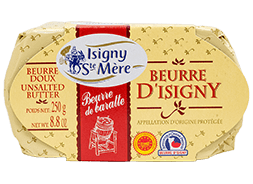
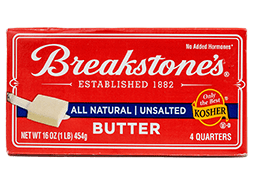
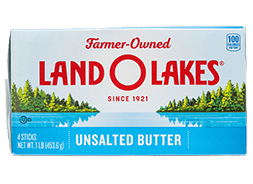


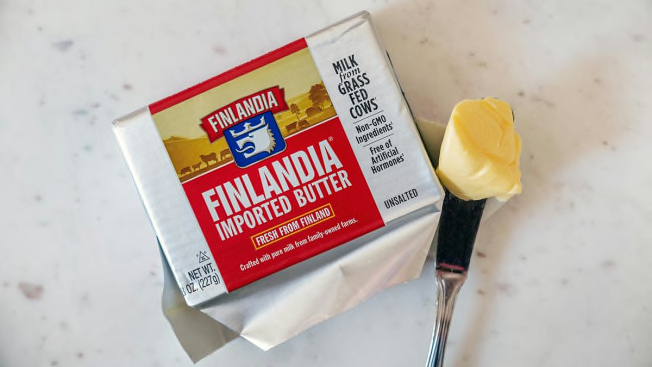
Most of the evaluators came to the butter tasting thinking that Kerrygold was king and left with a new favorite: Finlandia. “This one is a keeper,” says Mary. “I could eat it again and again.”
This butter from Finland has a glossy sheen and, as Theresa puts it, “spreads satisfyingly.” It’s silky but doesn’t melt too fast. “Hangs around long enough for you to appreciate it,” says Trisha. It’s dense and velvety, like a chocolate truffle.
The unsalted butter has a natural, well-rounded, clean flavor with no aftertaste. “This one is for a butter lover, for sure,” says Paul. It comes wrapped in a thick foil wrapper, which protects the butter against off-odors. Its aroma is light and pleasant, almost floral. I joked that I would wear this as a perfume, but I’m becoming more serious about that sentiment as I eat through this brick of butter.

If you can’t get your hands on Finlandia (above), the unsalted Isigny Ste Mère is similarly priced and excellent. This French butter tastes grassier, sourer, and has a stronger scent. The texture is glossy and smooth, but some consider it too spreadable, almost like a margarine’s level of slickness. If you opt for Isigny Ste Mère, skip the salted version, which is way too salty, mottled with yellow spots, craggy in texture, and tastes stale.
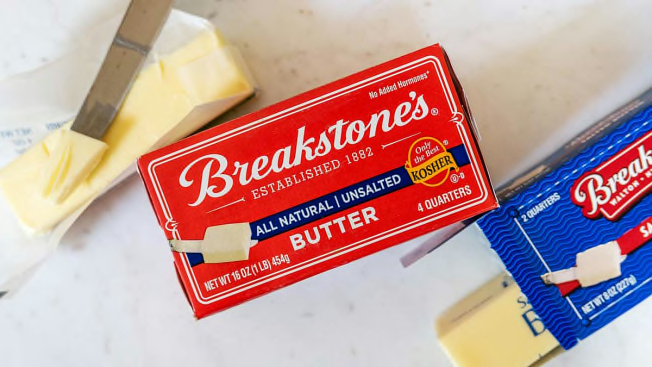
Breakstone’s butter isn’t going to blow your mind, but it’s not going to break your budget either. It’s a solid workhorse for everyday use, but it’s not the best for baking, so get the Land O’Lakes (below) for your holiday baking marathon.
Some of the cheaper butters we got smell aggressively buttery, like movie-theater popcorn (a sign that this scent was an added ingredient). Breakstone’s buttery aroma is just right and doesn’t smell fake. The unsalted Breakstone’s butter has a smooth texture with “enough body that it doesn’t sink into the bread but nicely coats it,” says Trisha. In the mouth, it’s a little gummy and greasy but has a good cream flavor (more cream than butter) with distinct sour notes. Paul says, “It has a dairylike complexity that is really nice.”
The salted version had a slight cardboard smell but tasted better than others at this price. Many other samples tasted old, smelled like the refrigerator, and were sharply salted.
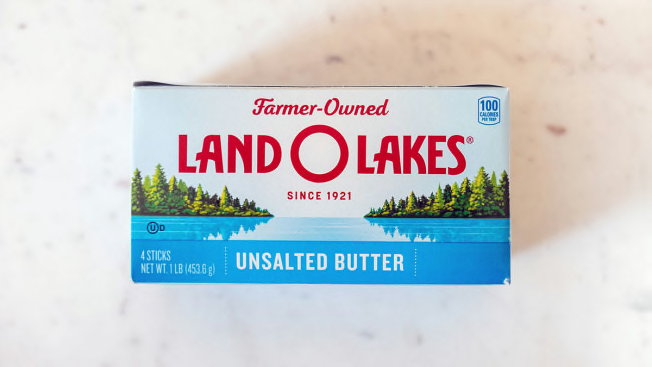
The pound cake made with Land O’Lakes unsalted butter has a semi-even color with a very moist melt-in-your-mouth crumb and buttery aroma. The tablespoon markings on the butter wrappers are easy to read and properly aligned along the length of the butter (something that is all too uncommon).
The butter is not too soft and it’s easy to cut, an important factor when preparing pie dough or biscuits, says Kathryn Gordon, the chief pastry and baking arts instructor at the Institute of Culinary Education in New York. “Generally, European-style butters are easier to work with due to the higher butterfat content.” Land O’Lakes also makes an “extra creamy” European-style unsalted butter that might be even better for baking, though we didn’t test it out. (Higher-fat butters might also be better suited for flaky pastries and cookies, but we only baked pound cakes in this evaluation.)
We wouldn’t recommend the Land O’Lakes as a table butter. On its own, it’s kind of gummy, greasy, and difficult to spread. And it has an in-your-face buttery aroma—like movie theater popcorn—but it doesn’t taste buttery. It’s all bark and no bite. This probably contributes to the buttery scent of the pound cake, but it was too much without the flour, sugar, vanilla, and eggs to offset it. The butter has a clean, mild, and flat flavor that might be ideal for baking but less so for spreading on your bread.

Finlandia (above) is actually our favorite salted butter, too, but Kerrygold comes close, and is much easier for most people to find. (Although the unsalted version didn’t fare as well.) The deep-yellow Irish butter has a nice buttery aroma that smells natural. The saltiness is well rounded but could use more sweetness, and the texture is very spreadable, but it can become too soft when left out at room temperature for hours.
But there are noticeable off-flavors, which some tasters chalk up to grassiness—Kerrygold says the butter comes from the milk of grass-fed cows, after all—but some found it off-putting. Trisha says, “The flavor has a distinct sourness that is strongest on the finish, but it isn’t pleasant.” The off-flavors especially come through in the unsalted version because salt helps to mask them.
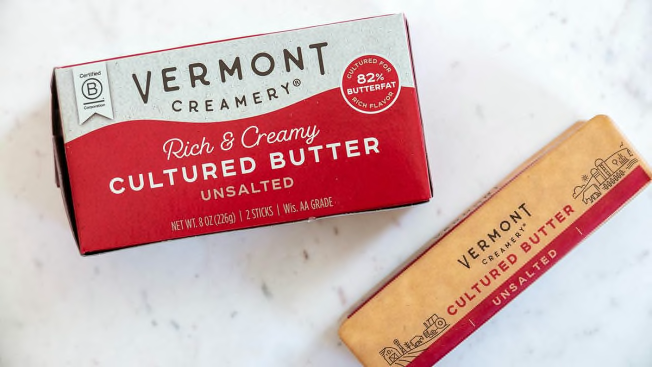
Of all the cultured butters we tasted, the Vermont Creamery sample was the only one noticeably cultured in its aroma and flavor. The butter is made from fermented cream that has been treated overnight with bacterial culture.
Its texture is full, almost fluffy, and very spreadable. It tastes complex and different from all the others, with some sour and bitter flavors. However, it smells and tastes more cultured than buttery. Still, it’s a nice and unexpected butter to set out on the table. “It’s sure to be a crowd-pleaser,” says Paul. And if you’re a salted butter fan, we found the salted version to be slightly and pleasantly salted—you’ll notice saltier spots, so it’s not evenly distributed, but I liked that about it.
Other Butters We Evaluated
Cabot: The pound cake baked with Cabot was the most beautiful and evenly browned but dry. Our butter sample was darker on the outside than on the inside, which is a sign of oxidation. And while the flavor was creamy with a little tang, it was barely buttery.
Horizon: The unsalted butter was slightly darker on the outside and had off-odors and off-flavors. It’s resistant and broke my plastic spoon when I tried to spread it, and its buttery scent was strong, but the flavor was flat with a bit of an aftertaste. The pound cake made with it turned out very middling in terms of appearance, texture, and flavor. The salted version tasted old and stale.
Lurpak: We found only the “slightly salted” Lurpak, which was a tad sharp, but the aroma was pleasant. There’s not much sweet butter flavor, though; it’s primarily creamy salt, says Trisha.
Organic Valley: This gummy sample also broke my spoon when I tried to spread it, and it took a while to melt in my mouth. Its aroma is faint and lovely, but its flavor is flat with an acidic aftertaste. “It doesn’t taste like anything, so why eat it?” says Trisha. Its salted version is sharply salty and uneven.
Plugrá: The buttery aroma is sharp and smells fake, while the flavor is flat with more of an aftertaste than anything. Several tasters also noticed sour, bitter, and peppery off-flavors and commented that the butter tasted more like solid oil than butter. The pound cake made with Plugrá was tender but blotchy and not buttery. The salted version had off-odors, pronounced sharpness, and was hard to cut, like cheddar cheese.
This product evaluation is part of Consumer Reports’ Outside the Labs reviews program, which is separate from our laboratory testing and ratings. Our Outside the Labs reviews are performed at home and in other native settings by individuals, including our journalists, with specialized subject matter experience or familiarity and are designed to offer another important perspective for consumers as they shop. While the products or services mentioned in this article might not currently be in CR’s ratings, they could eventually be tested in our laboratories and rated according to an objective, scientific protocol.
Like all CR evaluations of products and services, our Outside the Labs reviews are independent and free from advertising. If you’d like to learn more about the criteria for our lab testing, please go to CR’s Research & Testing page.
















